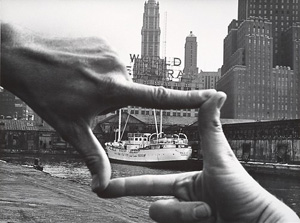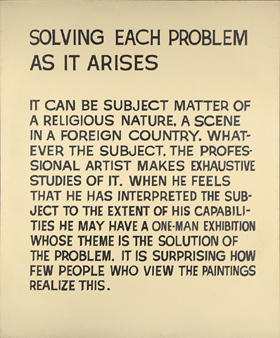Reality: What a Concept
John Haberin New York City
John Baldessari
One work by John Baldessari sticks with me. It was bound to, for its drone carries through at least three rooms of his retrospective.
In I Am Making Art, Baldessari repeats the title over and over, in as singsong a cadence as is humanly (or inhumanly) possible. At forty, the artist still had the awkward bearing of a twenty-something who has never learned to tuck in his shirt. Yet his scraggly beard and long hair already showed signs of gray. Not that one would know it from the 1971 video, which cuts off his head. One sees mostly his arms, in the stiff, random gestures of a feeble orator, a statue with the fidgets, or a private sign language without a message. What we've got here is an intentional failure to communicate. 
Welcome to a conceptual art that is ambivalent about art and ideas. It is also surprisingly hard to pin down. Is Baldessari making meaning or denying it? Is he making art?
Questions, jokes, and certainties
He is asking tough questions, but it may take a while to find them. One spots the lame jokes soon enough, for almost all his art sounds like a one-liner. For I Am Making Art, make that an endless stand-up routine. In a performance from a year later, he sings thirty-five statements by Sol LeWitt. In his best-known and funniest piece, he writes again and again I Will Not Make Any More Boring Art. He is boring even himself.
Instead of questions, one may see only punch lines and certainties. Baldessari has all the answers, and he has kept careful notes on them for more than forty years. A Painting That Is Its Own Documentation insists on that, starting with its title. The drab lettering on canvas includes every date from its conception (June 19, 1968, at 10:25 A.M.) through each and every public exhibition, right down to the present. The retrospective's last stop here in New York obliged him to add a seventh panel, much of it as yet a blank. What more is there to say?
For all that, the question ofCalifornia conceptualism will not go away—and an African artist, Steffani Jemison, has revisited Baldessari herself. For me, the realization came from a surfeit of certainties—the museum's wall labels. The Met stakes its claims for the artist on everyone from Francisco de Goya and Mickey Spillane to Elias Canetti. It quotes him for such profundities as "truth is beautiful no matter how ugly." Photos of boats that could not care less about Baldessari's gestures—or about his art? "The pain and anxiety of the act is counterbalanced by repeating it endlessly, perhaps obliterating the sadness."
Ouch. Suddenly the words on canvas sound really good. Now, I could put the inanity down to the curators. The Met never hesitates to inflate its claims in the interest of public education. Or I could put it down to an artist nearing eighty and losing perspective, especially about himself. He may have forgotten that he once multiplied his identity by hiding behind hats.
Then again, maybe Baldessari knows something. Maybe one should take his subjects literally, even at their most idealistic and naive—because maybe he does, too. His text paintings often focus on claims for esthetic purity, as if to mock anything but conceptual art. Yet his own nonsensical acts defy interpretation. The very idea of explanatory text to accompany text art is slightly comic, but so is painting the words no ideas have entered this work. After all, it is conceptual art.
The games go beyond the paradoxes to a view of art and understanding: artistic purity is itself a conception of art. In turn, art may depend on miscommunication in order to communicate. It may hide behind hats. It may even cut off the artist's head when he is making art. Maybe his jokes fall flat, but it is only by falling flat that they earn a smile.
The American dream
Baldessari is cool, detached, ironic, and totally at ease with the American scene in front of his eyes. His idea of conceptual art inspired more than a generation at CalArts, which also graduated Llyn Foulkes and Christopher Williams (and, before Baldessari arrived, Ed Ruscha and Ken Price), and it is precisely the version of Postmodernism that drives New Yorkers like me crazy. Yet it is also an extended riff on Pop Art and an extended homage to California. The Backs of All the Trucks Passed While Driving from Los Angeles to Santa Barbara on a day in 1963 anticipates Every Building on the Sunset Strip, by Ruscha three years later. The paint smears and tire treads on found billboards, also in the 1960s, render abstraction mute or moot. This may be conceptual art, but here the rubber hits the road.
His first surviving paintings could in fact pass for Pop Art without the seductions, charge, or fears. A floating cartoon nose from 1965 might have sniffed a cake by Wayne Thiebaud in Thiebaud drawings and turned away. As he turns to conceptual art, he disdains the seductions and fears of others as well. That includes more sign painting, such as Tips for Painters Who Want to Sell or a quote on "esthetic judgments" from Clement Greenberg and supporters like Pat Lipsky. The retrospective, organized by LACMA and Tate Modern, calls itself "Pure Beauty"—after a 1968 canvas bearing just those words and nothing more. As they say, beauty is in the eye of the beholder.
These paintings shun the cryptic poetry, philosophy, and austerity of another conceptual artist, Lawrence Weiner. Where Weiner's text often refers to materials and vision, Baldessari's is utterly, painfully explicit. Where Weiner is indifferent to whether a work's directions are ever executed, Baldessari is indifferent to the execution—and there is a difference. That is why he works with text from others, on canvas rather than on the wall. It is why he leaves the execution to others, like the police sketch artist who works from descriptions of his photo. Those looking for private thoughts behind his gray panels had better ask the professional sign painters responsible.
 He also shuns the collision between concept and execution in another form of conceptual art, that of LeWitt. Who knows what the instructions for a Minimalist wall drawing might produce, if only the song ended? Instead of LeWitt's visual overflow, Baldessari favors forced alignments. He arranges photos of a ball in flight so that it forms not an arc but a row. He frames a harbor (or at least a photograph of one by Shunk-Kender) with his hands and a woman with a distant tree, so that she appears to lean forward to kiss it. When he waves as ships arrive and depart, he erases distinctions in time as well.
He also shuns the collision between concept and execution in another form of conceptual art, that of LeWitt. Who knows what the instructions for a Minimalist wall drawing might produce, if only the song ended? Instead of LeWitt's visual overflow, Baldessari favors forced alignments. He arranges photos of a ball in flight so that it forms not an arc but a row. He frames a harbor (or at least a photograph of one by Shunk-Kender) with his hands and a woman with a distant tree, so that she appears to lean forward to kiss it. When he waves as ships arrive and depart, he erases distinctions in time as well.
As he turns more and more to photography and film clips, he almost leaves conceptual art behind, like James Rosenquist on the cheap. A blond licks fruits, guns surround kisses, and pelicans appear to stare at a woman with her nose bleeding. By then he had long since decided to destroy his work and to bake cookies from the ashes. The Cremation Project of 1970 replaces the tragedy of a studio fire, as for Arshile Gorky, with a mockery of ceremony. Yet it also replaces an artist's self-doubt with the American dream of self-making and renewal. To rub it in, he spared from the fire a good four years of work.
With the 1980s, he aligns B-movie archives and free associations. At first, stock footage acquires labels, like the seven deadly sins and the seven virtues. He might as easily have written This Is Not a Pipe below Bogart smoking a cigarette. More recently, arrangement becomes itself the point. One work leaps across supply-store poster frames, guided by images of picture frames. Rather than what René Magritte called The Treachery of Images, one has the treachery of the artist.
Pointing fingers
Can art honestly make meaning out of nonmeaning, even if that nonmeaning is America? As Ludwig Wittgenstein writes in Philosophical Investigations:
But if a sentence can strike me as a painting in words, and even a single word in a sentence as a picture, then it is no more astonishing that a word uttered in isolation and without purpose can seem to carry a particular meaning within itself.
Not every image here has that power. In fact, fewer and fewer do after the 1970s. The artist grows increasingly boring after promising not to make boring art, and this time I do not mean boring as a compliment. He provides a bridge from Pop Art to Postmodernism all the same.
A strategy of alignment rather than collage recalls Modernism's preference for the literal over metaphors. It repeats structuralism's distinction between the synchronic, or associative, and the diachronic, or one thing after another. As Baldessari says, "As soon as you put together two things you have a story." So what if it is a very, very short story? It also anticipates the chilly juxtapositions of David Salle, which resist teasing apart. Salle studied with him, as did Jack Goldstein, Troy Brauntuch, Barbara Bloom, and others of the "Pictures generation."
Some, believe it or not, take "Pure Beauty" seriously, citing Baldessari's photographs of colored paper flung from a window. This would make sense if he cared about the choice of color. Elsewhere color hardly appears at all, except as slightly disgusting invented names for slightly disgusting standard color swatches. Another video shows students painting the walls and ceiling of a small room a single color. Sped up, it laughs simultaneously at composition, Minimalism, and process art. In a recent work, the colors become the outlines of a man climbing skyscrapers—like a superhero or a suicide.
He sings LeWitt, knowing that he cannot carry a tune. He refuses to make boring art, but of course the act of repetition is boring. That refusal began with an invitation to exhibit in Nova Scotia, without funds to travel. He sent instead the words, with instructions to write them repeatedly until they filled the gallery walls. He describes it as punishment, but his recipients complied—and in his performance video they get their revenge. He then gets his revenge on museum-goers forced to listen.
With one hundred and forty works, his retrospective demands more than its share of looking and listening. It may seem to go on forever, but it also takes far too little time or attention for a great show. Or maybe that, too, is part of the puzzle. Is I Am Making Art insightful, critical, sincere, or simply infuriating? Is Baldessari? "All of the above" is just one possible an answer.
Distrust of art as truth, beauty, or self-expression has deep roots, from Plato through Postmodernism. Wittgenstein argued that you could never have a private language, intelligible to no one else. If you did, though, you would "have the feeling of pointing into yourself." The Met quotes Al Held: "all conceptual art is just pointing at things." Ever since the robotic gestures of I Am Making Art, Baldessari has been pointing fingers.

"John Baldessari: Pure Beauty" ran at The Metropolitan Museum of Art through January 9, 2011.




